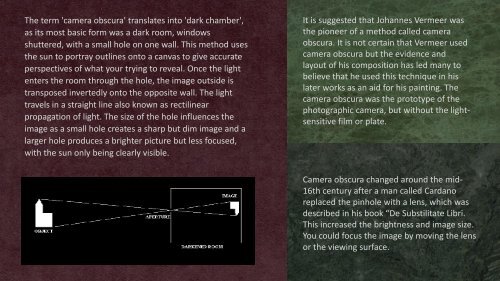You also want an ePaper? Increase the reach of your titles
YUMPU automatically turns print PDFs into web optimized ePapers that Google loves.
The term 'camera obscura' translates into 'dark chamber',<br />
as its most basic form was a dark room, windows<br />
shuttered, with a small hole on one wall. This method uses<br />
the sun to portray outlines onto a canvas to give accurate<br />
perspectives of what your trying to reveal. Once the light<br />
enters the room through the hole, the image outside is<br />
transposed invertedly onto the opposite wall. The light<br />
travels in a straight line also known as rectilinear<br />
propagation of light. The size of the hole influences the<br />
image as a small hole creates a sharp but dim image and a<br />
larger hole produces a brighter picture but less focused,<br />
with the sun only being clearly visible.<br />
It is suggested that Johannes Vermeer was<br />
the pioneer of a method called camera<br />
obscura. It is not certain that Vermeer used<br />
camera obscura but the evidence and<br />
layout of his composition has led many to<br />
believe that he used this technique in his<br />
later works as an aid for his painting. The<br />
camera obscura was the prototype of the<br />
photographic camera, but without the lightsensitive<br />
film or plate.<br />
Camera obscura changed around the mid-<br />
16th century after a man called Cardano<br />
replaced the pinhole with a lens, which was<br />
described in his book “De Substilitate Libri.<br />
This increased the brightness and image size.<br />
You could focus the image by moving the lens<br />
or the viewing surface.





